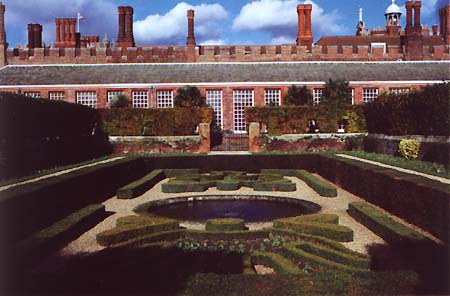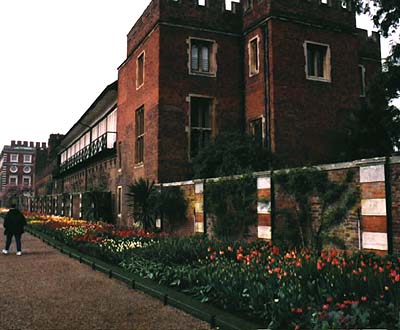Hampton Court Palace
Location: East Molesey, Surrey
ADMISSION INFORMATION
Directions by Train: Waterloo Rail Station to Hampton Court
Directions by Boat: Riverboat from Westminster Pier
|
 History
History
 Part of the rear facade of the palace with gardens. Once Hampton Court became property of the king, it was necessary to extend the building to accommodate the Tudor court, numbering around 1000. It became the favored country palace of Henry VIII and five of his six wives lived there as well. Anne Boleyn's gateway between the Base and Clock Court recalls his second wife. It remained a royal residence (Oliver Cromwell even retained the property for his own use) until the 1760 death of King George II and underwent many structural changes during this time. The most notable improvements to the palace began in 1689, shortly after the ascension to the throne of William III and Mary. With Louis XIV's Palace in Versailles as inspiration, architect Christopher Wren was instructed to begin work on the conversion of the Tudor Palace. Wren's severe Baroque design incorporated the use of red brick and white stone accents with exquisite masonry throughout. Brick was used, but richly embellished with Portland stone for the arcades, windows, friezes and parapets. The new structure was located to the south east of the original palace and was completed in 1700.
 Palace courtyard with Wren exterior.
  The Hampton Court Palace Maze and Great Vine
|
 The Palace Today
The Palace Today
Much of the 1000 room palace exists as it did at the time of the last monarch to reside there, George II in 1760. The Queen still owns this property and it is occupied and meticulously maintained. In addition to the main house, the gardens and outdoor attractions are very popular with visitors. The astronomical clock in Clock Court was created for Henry VIII in 1540. The mechanism had to be replaced in the 18th century, but the dial is original. It records the passing hours, days, months, phases of the moon and tells the time of the high tides at London Bridge. Also built for King Henry VIII were the closed tennis courts. The first of their kind, these courts offered the king and his guests the choice of playing real or Royal tennis. They are situated close to the palace. The gardens on the palace grounds are known for their beauty and originality. In addition to the hedge maze and Great Vine, there lies amid the gardens the Banqueting House and Orangery. The Palace houses magnificent collections of tapestries, furniture and clocks. It also boasts a collection of paintings by such artists as Holbein, Lely and Tintoretto.
 The side of the Palace |
 The Palace Today
The Palace Today
Links to my other London Attractions pages The Royal Palaces Official Website Need further information,? Click Here
 Last Updated: 9 May 2004 All photographs ©1997-2004 MD Cerny unless otherwise indicated. Contact me prior to reproduction/use in a public forum to obtain my permission. Please leave your contact information and the URL where the photograph(s) will be used (if applicable) via the email link above. In exchange for their free use, a small, name text link to my site is required on each page where my photographs are posted. Click here for full legal copy and information about obtaining permission to use my photography. NOTE: Some photographs on this page may not be my own and were copied from non-copyrighted images. |